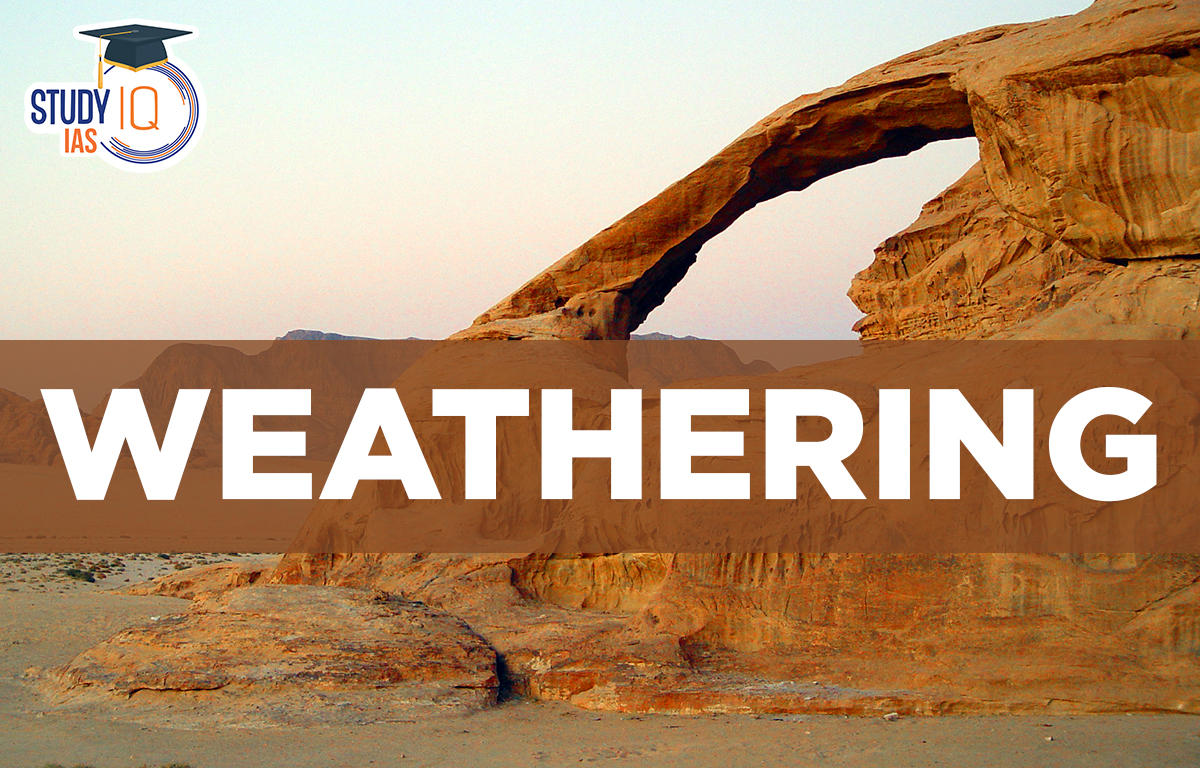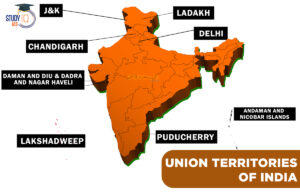Table of Contents
Weathering Definition
Weathering can be defined in simple terms as the action of weather and climatic factors (e.g. temperature and rainfall) over Earth materials. The weather and climatic factors can either act individually or collectively to break the surface materials into fragments (disintegration). Weathering is the primary stage of denudation. The surface and subsurface rocks break up, dissolve and decompose to disintegrate into fragment materials. As minimum material movement occurs in the weathering phenomenon, it can be called the in-situ weathering process.
Weathering derives energy from insolation guided by the surface of the Earth, including the atmosphere. Weathering helps form minerals and soil formation, which encourages agriculture and human settlements. Weathering is a complex process dependent on factors like climatic, topographic, and vegetative factors.
Weathering Types
Weathering is classified into three types:
All three processes are together found to be in operation. Very rarely does any one of these processes operate independently.
Physical Weathering
Physical weathering is caused by applied forces, such as water pressure, thermal expansion forces, and gravity forces. The rocks are harmed by these processes’ repeated action.
Chemical Weathering
Through a series of chemical reactions involving oxygen, surface or soil water, and other acids, a group of weathering processes known as the solution, carbonation, hydration, oxidation, and reduction act on the rocks to break them down, dissolve them, or reduce them to a fine clastic state.
Biological Weathering
Biological weathering is the addition of minerals and ions to the environment that is being weathered or their removal, as well as physical changes brought on by the growth or movement of organisms.
Humans also contribute to the development of new contacts between air, water, and minerals in earth materials by uprooting vegetation, cultivating soils, exposing new surfaces to chemical attacks and wedging by species like earthworms, termites, rats, and others.
Read More: Types of Rocks
Weathering of Rocks
Rock near the earth’s surface disintegrates as a result of weathering. The main contributors to weathering are water, air, and plant and animal life. Rock’s surface minerals are loosened and weathered so that erosive forces like water, wind, and ice can carry them away.
Read More: Mass Movement
Weathering Significance
- The initial phase of soil formation is weathering.
- If the rocks are not worn, roots cannot penetrate them.
- It promotes erosion, massive waste, relief reduction, and changes to landforms.
- Other natural resources produced by it include clay, which is used to make bricks.
- The fact that weathering weakens the rocks and makes them simpler to exploit and break, for example through mining and quarrying, is another important aspect of weathering.
- Vegetation produces biomes and biodiversity, and forests depend on the intensity of weathering processes.
- Rock weathering aids in the enrichment and concentration of some ores like manganese, aluminium, iron, copper, etc. that are highly sought after in the nation’s economy.
- When certain rock fragments and particles are broken down, sediment is eventually produced. Sedimentary rocks like sandstones and limestones are formed from these sediments. Sedimentary rock is typically formed when shattered rock fragments are compressed under intense pressure and deposited by rivers.
- Some worn rocks are incredibly fascinating, like granite tors. They act as tourist attractions as a result. One illustration is the Bismarck rock near Mwanza, Tanzania.
- Locals are mystified as to how some of these rocks came to be because they seem to be so unique. They have transformed them into neighbourhood shrines where worshippers can make sacrifices.
Difference Between Weathering and Erosion
The processes that reduce rocks to little particles are erosion and weathering. Erosion is the process through which water and wind carry away rock fragments. On the other hand, weathering deteriorates the rocks without moving them.
| Erosion | Weathering |
| It is the shifting of solids caused by ice, water, and wind. | It is the direct atmospheric contact-induced breakdown of minerals, soil, and rocks. |
| Water, wind, ice, thermal, and gravity erosion are the various types of erosion. | Physical, chemical, and biological weathering are among the various types of weathering. |
| Materials that have been eroded are moved. | The deteriorated items are not moved. |
| Among the factors that contribute to erosion are wind, water, ice, and human activity. | Air pressure is one of the atmospheric elements that contribute to weathering. |
Weathering UPSC
The process of wearing down, fracturing, and fragmenting the rock that makes up the surface of the ground and is left out in the elements is referred to as weathering. The process is the outcome of weather-related factors such as frost action, temperature changes, and rain action.
A solid understanding of this subject is required to help individuals pass competitive exams. On that note, we have covered this topic exclusively for students preparing for the UPSC and IAS exams.


 Indian Sex Ratio 2024 State-wise, NFHS-5...
Indian Sex Ratio 2024 State-wise, NFHS-5...
 Union Territories of India with Capital ...
Union Territories of India with Capital ...
 Rowlatt Act 1919, Meaning, Provisions, R...
Rowlatt Act 1919, Meaning, Provisions, R...

















